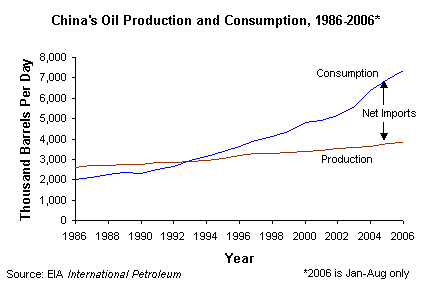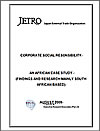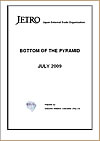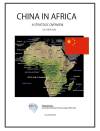China in Africa
All data are collected in the Fiscal Year of 2008-2009.
2. Africa in the Context of China's Resource Acquisition Requrements
Fundamental structural economic reforms undertaken by the Chinse government duringthe 1980s and 1990s, transformed what was an essentially stagnating agrarian economyinto the worlds fastest growing economy third in size only to Japan and The united States(US). Since the 1980s China has consistently enjoyed an average economic growth rate ofover 8 percent per annum.
A signal of China’s growing economic strength was its rising need for oil imports. In 1993China became a net importer of oil, and in 2003, overtook Japan to become the world’ssecond consumer of oil behind the US. Between 1978 and 2000, energy demand inChina grew at 4 percent per year; but since 2001, demand has soared to 13 percent peryear, outpacing annual economic growth. China consumed an estimated 7,8 millionbarrels per day (bpd) of oil in 2008. However, during that same year, China produced onlyan estimated 4 million bpd of total oil liquids, of which 96 percent was crude oil. China’snet oil imports were approximately 3,9 million bpd in 2008, making it the third-largest netoil importer in the world behind the United States and Japan. EIA forecasts that China’s oilconsumption will continue to grow during 2009 and 2010, with oil demand reaching 8,2million bpd 2010. This anticipated growth of over 390 000 bpd between 2008 and 2010represents 31 percent of projected world oil demand growth in the non-OECD countries forthe 2-year period according to the July 2009 Short-Term Energy Outlook. On 6 October,Dow Jones Commodities News Service quoting Comex stated that China’s oilconsumption in the first quarter of 2010 would reach 8,36 billion bpd. US crude oilconsumption is roughly 21 million bpd.
Not surprisingly China considers oil procurement a matter of “national security, using allstate resources to satisfy the nation’s need for energy.” An indication of the potentialenergy crisis China faces is illustrated by the projected growth of motor vehicles in thecountry from 27 million in 2004 to an estimated 300 million in 2030. By 2030, China willneed an oil “supplier the size of Saudi Arabia to meet demand, and even this may be aconservative assessment.
China's Oil Production and Consumption, 1986-2006

Source: EIA International Retroleum
The bulk of accountability for the enormous energy demands in China rests on its renewedfocus on energy-intensive industry – led by China’s obsession with the manufacture ofsteel and related metal products. Industry in China consumes up to 70 percent of totalconsumption, followed by residential at 10 percent, transportation 7 percent andcommercial at just 2 percent. But industrial production also generates some of the highestprofit margins, outstripping the more labour intensive but less energy intensive lightindustries like textiles and electronic/computer machinery and production. Not only doesthe industrial base deliver so many of the manufactured goods for the rest of the world butit also must support the enormous urbanization movement which now accounts for over 39percent of the population, and the infrastructure and building that will support it.
Consequently, China is the number one steel manufacturer and exporter in the world,accounting for 34,6 percent of the world’s share of production. Iron and steel, alone,account for 16 percent of china’s energy consumption (total heavy industry accounts for 54percent of total consumption).”
The growth of the industrial base coupled with increasing individual household wealth,places a great demand on China for sourcing both more raw resources and exportmarkets. China now imports 20 percent of the world’s fuel and mining products. It is theworld’s largest producer and consumer of coal, the worlds largest importer of iron ore, theworld’s largest importer of coking coal, and so on. It has displaced the US as the world’slargest consumer of raw materials as a whole.
[Note: According to the Chinese Ministry of Land and Natural Resources, by 2010domestic crude oil production will only be able to meet 50–55 per cent of demand falling to34–40 per cent by 2020; while domestic iron production will be able to meet 38 per cent ofdemand by 2010 and only 29 per cent by 2020. It is estimated that by 2010 and 2020 theshortage of coal will reach 250 million and 700 million tons respectively. So China islooking to Africa to address some of its short to long-term needs.]
2.1. The Defining Pillars of Foreign Policy
David Zweig and Bi Jianhai writing in an article, "China's Global Hunt for Energy," in theSeptember/October 2005 issue of Foreign Affairs , state that China’s foreign policy has hadto increasingly reflect the domestic policy imperatives of ensuring a smooth uninterruptedflow of raw materials imports to satisfy its burgeoning economic growth path. This it hasdone by encouraging state-controlled companies to seek out exploration and supplycontracts with countries that produce oil, gas, and other resources. At the same time,Beijing aggressively courts the governments of those countries with diplomacy, tradedeals, debt forgiveness, and aid and security packages – an effective combination notseen in Western countries.
A second influence on China’s foreign policy rests with a different aspect of its economicgrowth – increasing its global competitiveness and reframing its pattern of growth. SinceChina’s accession to the World Trade Organization (WTO) in 2001, and the establishmentof the official “Go Out” and buy strategy for Chinese businesses, China has beensupporting the growth of its multinationals in the international arena. The goal is toincrease domestic consumption and alleviate the constraints of export-led growth. For thisit needs to engage with global markets.
The “Go Out” policy selects 30-50 of the states best performing state-owned enterprises,which will then receive government benefits to help “develop these corporations’”technological skills and know-how, exploit China’s comparative advantages, gain accessto key inputs, open new markets abroad, create global Chinese brands, and help Chinaavoid becoming over-dependent on export-led development. A critical component of thispolicy is to “lock-in” resources that China would otherwise have to purchase on the openmarket. This is done be securing long-term supply contracts with host countries andcontrolling the chain of supply from source to end point user in China. [See below.]
Chinese banks (backed by government policies) have encouraged businesses to investand develop outside the mainland. Much of China’s foreign policy in Africa has reflectedthe strategies outlined above. The establishment of the $5 billion China-AfricaDevelopment Fund (CADF) to assist businesses willing to invest in Africa, for example, is atestament to its reevaluated economic focus on transitioning to an economy based onexpanding domestic consumption. Chinese businesses investing outside the mainlandhave been aided by the creation of Sinosure, which offers export credit insurance to helpChinese businesses obtain cheaper loans from private banks, and by offering reduced rateof loans from the China Export Import Bank and the China Development Bank (CDB). Infact, outward foreign direct investment (FDI) to Africa grew 327 percent between 2003 and2004 and there are now over 900 Chinese companies operating on the continent.
The final determinant of China’s foreign policy is diplomatic. There are two stated goals:one, to support the One China policy and further isolate Taiwan; and two, to helprebalance the hegemony of the US in international relations. In its role as “anti imperialistcounterweight to the West,” China has brokered diplomatic ties with resource richcountries that bear pariah status, but bring much needed resources to China. Here Africaagain plays a crucial role.
A secondary aspect to China’s diplomatic outreach is to reinforce a new developmentmodel for developing countries, one mirrored on its own focus of economic growth beforedemocratic growth. Explained by Professor Yang Guang at the Africa-China-US TrilateralDialogue held in Washington DC in 2007, there must be a balance of reform, stability anddevelopment…that democratization should not be precondition to development.” Instead,this is allowing for countries to seek their own models applicable to their unique conditions– a strong corollary to its non-interference policy.
In Africa, this diplomatic offensive is given a measure of coherence within the politicalframework provided by such institutions as the Forum on China Africa Cooperation(FOCAC) and the China-Arab Cooperation Forum (CACF). Established in October 2000,FOCAC has taken center stage in symbolizing the new political engagement that Chinahas forged with Africa. Linked to its formation has seen an emerging consensus aroundcrucial foreign policy considerations salient to China’s geo-strategic views on resourceacquisition and the desire to change the hegemonic influence enjoyed by the West inshaping the characteristics of the current economic world order.
These include the recognition of “non-interference” as the corner-stone of bi-lateralrelations between countries, and dealing with radical Islamism, debt relief, reductions intariff barriers, immigration, peace-keeping missions and challenging the “WashingtonConsensus” which dominates the thinking of multi-lateral agencies such as theaInternational Monetary Fund (IMF) and World Bank.
Embedded in this overarching policy construct are specific institutions dealing with Africandevelopment issues such as CADF and the China-Africa Business Council (CABC) toleverage Chinese economic influence on the continent within the context of its “go-out”policy. All this is supported by a synergistic approach towards Africa coordinated in themain by the National Reform and Development Council (NDRC) and the InternationalLiaison Department (ILD) of the Chinese Communist Party (CCP) in conjunction withorgans such as the Ministry of State Security or Guangbo (MSS) and the all-powerfulMinistry of Commerce (MOFCOM), linked in turn to China’s banking behemoths. All thisprovides massive institutional backing to Chinese state owned enterprises (SOEs)breaking into African markets
Buttressing this diplomatic offensive is the principal of “non-interference” – the cornerstoneof China’s engagement with the developing world. This enables China to engage withunsavoury regimes not courted by the West. China’s strategy enables the continent’s mostdubious regimes to build up a rentier economy based on the massive exploitation ofnatural resources with very little real fixed investment flowing into that country and nopressure put on the regime to change. This is particularly so in a place like the DemocraticRepublic of Congo (DRC) where there is minimal fixed investment in mining – givenChina’s priority to beneficiate raw materials in China.
目次
- 1. Introduction
- 2. Africa in the Context of China's Resource Acquisition Requrements
- 3. The Origins of China's New Africa Policy
- 4. The Role of FOCAC
- 5. China's New Resource Acquistion Business Model
- 6. The Role of Chinese Institutions in the Acquisition of Business Intelligence
- 7. China's Energy Footprint in Africa
- 8. China's Mining Footprint in Africa
- 9. China's Telecommunications Footprint in Africa
- 10. China's Infrastructure Footprint in Africa
- 11. The Role of China's Financial Institutions
- 12. Implications for Japanese Investors
- Annexure I: The Focac Fuc Structure
- Appendix II: The Forum on China-Africa Cooperation
- Annexure III: Ministry of Commerce
- Annexure IV:Profile Chen Yuan and Chi Janxin




